Touring war-torn Bosnia and Croatia (+Vienna) in 2012
(Travel Story series @ Hon Too Fang 2018)
In June 2012 we joined a small group tour to Bosnia and Croatia for 2+ weeks.
*A 1 -- why Bosnia?
There is a story. We don't have a live-in maid, only a part-time one. One day this maid was doing some ironing and checking with the lady boss a certain shirt belongs to the boss or the boss' son. I was on the phone with my friend Peter, who asked me where would be my next travel destination. The maid had some hearing problem. The lady boss had to literally shout, "boss pun nya." Peter might have some hearing problem too. He overheard it was "Bos nya" and said, "Oh, Bosnia, Sarajevo, heard of it, not been there yet." Peter's words are always inspirational on travel matters. So to Bosnia we went.
*A 2 -- why Croatia?
Bosnia is a Muslim nation. My wife is strongly Catholic. Visiting a Muslim country? Meeting men with 4 wives? Must visit a strong Catholic nation to balance the influence, she insists. Where else could be more Catholic than Croatia with nearly 90% Catholic? So to Croatia we went.
** B - Introduction and the 1992-95 Civil War
*B 1 -- Where are Bosnia / Croatia
These are small countries in south-eastern Europe, formed in 1991/92 after the former communist nation Yugoslavia disintegrated. Bosnia's full name is Bosnia and Herzegovina. It has an area of 51,000 sq km and a population of 3.8 million. Ethnically, about 48% Bosniaks, 37% Serbs, 14% Croats. Slightly less than 50% Muslims. It has 2 autonomous entities: the Republika Srpska, Serbs dominated. We were in the Federation region, Bosniaks and Muslim dominated. Note that Bosniaks refer to a race, while Bosnians refer to the citizens of Bosnia which include Bosniaks and other races.
Croatia is slightly larger, population 4.3 million. Near 90% Croats, a very "pure blood" nation. Nearly all Croats are Catholics.
Sharing boundaries with them is Serbia, which we didn't go. A bigger country and more populous.
*B 2 -- Who are the Bosniaks, Croats, Serbs
Who are these 3 races fighting one another in the 1992-95 Civil War? In fact they are of the same "original" race. In appearance they look the same. They are all descendants of the Southern Slavs who came to this region around the 6th century. It is religion that alienates them. Those Slavs who were ruled by the Roman Empire and continued embracing Catholic Christianity are the Croats, those living in areas ruled by the Byzantine Empire and followed Orthodox Christianity are the Serbs and those living in land later conquered by the Ottoman Turks and converted to Muslims become the Bosniaks.
Could you tell which races are these 3? No idea? The 1st is a Croatian, the 2nd a Bosniak, and the last a Serb.
The Muslims in Bosnia are very liberal. Women in low-cuts, short skirts, men drink beer. Certainly no Sharia law. Inter religious marriage no problem. Shown a casino in rural Bihac and a notice in a novelty shop in Mostar.
*B 3 -- The Civil War 1992 - 1995
This is the War of Independence fought within our time. The former communist nation of Yugoslavia was made up of 6 socialist republics. After the disintegration of communist Soviet Union in 1991, 2 republics, Bosnia and Croatia wanted independence from Yugoslavia and unilaterally declared so. But the most powerful republic, Serbia, refused to let them go. So civil wars erupted on many fronts. The Serbs controlled the former Yugoslav army and won the battles in the initial stages. It was a bloody love triangle too. The Bosnians and Croatians first fought between themselves and later fought together against the Serbs. All about control of territories and resources. Bosnia suffered the most. The civil war ended after the intervention of the European Union, NATO, etc.
*B 4 -- Victim of the Civil War
War is not about who is right. War is about who is left. Left standing. These buildings are war victims in Mostar and Bihac, both in Bosnia, yet to be re-constructed.
*B 5 -- Another war victim
Bright orange red roofs of buildings inside the old city of Dubrovnik, Croatia, viewed from the 3-storey high city wall. A UNESCO World Heritage Site. Victim of war? Yes. Most of the roofs were destroyed in the Civil War but they have been replaced. Now a lively brilliant orange scenic sight. Change is good. May be one for GE 13?
*B 6 -- Roses of Sarajevo
The Rose of Sarajevo is a concrete scar on the pavement caused by a mortar shell's explosion during the Civil War, and later filled with red resin. Mortar rounds landing in concrete create a unique floral pattern of fragmentation. Only explosions with 1 or more deaths were marked this way. And of course there are many.
Promoting tourism with blood? Or prolonging the hatred?

*B 7 -- The other war
In 1914, this region was a territory of the Austro-Hungarian Empire. On June 28, the Archduke (crown prince) Ferdinand was assassinated by a nationalist Gavrilo Princip in Sarajevo and this incident triggered the First World War. The assassination took place near the northern end of the Latin Bridge, shown below. The northern end is on the left of this photo.
The assassination story is fascinating. On this fatal day the nationalistic movement placed 6 assassins on the route where Ferdinand's 6-car convoy was supposed to travel from the railway station to the Town Hall along this road called Appel Quay. Princip was the 4th assassin. The first 2 didn't do anything. The 3rd threw a bomb but it fell off Ferdinand's car and exploded on the ground damaging the following car. The convoy sped off and the assassin Princip had no chance to act. He loitered around there and later went "limp kopi" at the "mamak stall" near the Latin Bridge.
The crown prince was not supposed to come back on this route. But because of the bombing, Ferdinand decided on a change of plan after his business at the Town Hall. He decided to visit the injured officer at the hospital and their convoy came back to this Appel Quay. Because of the change of plan and route there was some miscommunication. No mobile phone yet. No GPS too. Certainly no "Waze". Ferdinand's car made a wrong turn somewhere and had to reverse. But the early 20th century car was even less reliable than our Proton Saga. While reversing the gear jammed and the car stalled. The open-top sports car stalled right in front of the cafe where Princip was enjoying his "kopi tarik". What a lucky day. He came out and shot the crown prince and his wife at point blank range, killing both.
So you can image what an unlucky day this Ferdinand had, to be killed like that. Change of route and stalled car! And you say buying that 4D number for 7 years and never strike any prize bad luck?
** C -- What to see? We are now in touring mood, first to Croatia
*C 1 -- Zagreb, capital of Croatia
The main square, Bana Jelacic Square, was gripped by football fever: Croatia was playing in the Euro 2012 Finals, though the mood was subdued as they did not advance beyond the group stage.
And the imposing Zagreb Cathedral of the Assumption of Mary, and some statues.
*C 2 -- Plitvice Lakes, Croatia
This is the "Juizhaigou" of Europe: with hundreds of waterfalls and lakes, and pristine water. Water seems to ooze out from every slope, the Hong Kong people would like it: everywhere "sui", lots of water or money. This is a UNESCO World Heritage Site. Crystal clear water, boardwalk trails, simply tranquil.
*C 3 -- Hvar Island, Croatia
This is an island resort by the Adriatic Sea. A very expensive place, a 3-km taxi ride cost us RM 60. Shown the old fortress and the water front as viewed from the old fortress. Notice the size of the giant cruise ship? Shown yachts of different sizes at the sea front and 2 buildings: the iconic St Stephen Cathedral first built in the 14th century and an unusual external staircase to the roof top of a house.
*C 4 -- Split, Croatia
The Diocletian Palace was built in the 3rd century for the Roman Emperor Diocletian as a retirement home. It occupies half of the old town of Split, a UNESCO World Heritage Site. The giant statue of Bishop Gregory of Nin stands outside the Palace. He was a 10th century Croatian Bishop who introduced reforms to the local church. This town has a vibrant waterfront too.
*C 5 -- Dubrovnik, Croatia
Dubrovnik, fronting the Adriatic Sea is a major tourist destination in the Mediterranean region. It was founded in the 7th century and prospered due to maritime trade. The walled old city of Dubrovnik is a UNESCO World Heritage Site. The walls are up to 3-storey high and 2 km in length. Some buildings are dated to the 16th and 17th centuries
Some interesting structures as viewed from the top of the wall
The round thing below is the Onofrio's Large Fountain, where water is made available to the public, for drinking or cooling your head on a hot day. The 3rd photo shows the Onofrio's Small Fountain.
As usual there are many churches. Shown upper facade of the Catholic Cathedral, and the internal decoration of the Holy Annunciation Orthodox Church. And 2 photos of lighter moments: colourful parrots on parade and colourful dolls “hanged” from the window of a souvenir shop.
** D -- What to see? Now we are in Bosnia
D 1 -- the country side, Bosnia
Typical rural scenes in Bosnia, not much forested land in places covered by us.
D 2 -- Bihac, Bosnia
Bihac is a small city in the northwest region of Bosnia, with a population of some 55,000. We stayed at a hostel called Vila Buk out of town, nestled in the green forest, with many wild flowers and apple trees. And more of the scenic neighbourhood further away
12 in our group went white-water rafting along River Ina near Bihac, including a 71-year old man and a 75-year old woman. In 2 rafts. At the end of 4 hours: aching arms, sore legs, empty stomachs, thirsty throats, but full of joy of experiencing. This 1st photo actually shows the “fall” of another group, not ours, but our people went through the same route, but photo not taken. Miss the split-second shot.
*D 3 -- Medugorje, Bosnia
Medugorie is a village near to the Croatian border. Most of the residents are Croats, and Catholics. The Virgin Mary, mother of Jesus, was said to have first "appeared" to 6 children here in 1981. She made many more appearances later. A church, St Jame's Church, was built at the village. However the apparition site was in the mountain, not anywhere near the church. This is a popular pilgrimage site for Catholics even though the Vatican has not recognised the claim of apparition.
*D 4 -- Mostar, Bosnia
Mostar, population 105,000, is the most important city in the Herzegovina region in Bosnia, serving as its cultural and financial capital. The town center is a UNESCO World Heritage Site. Many old buildings use thick natural slate plate as roofing material.
The most famous landmark is the Old Bridge, the original built in 1566, 4 m wide and 30 m in span. The original was cruelly destroyed by Croatian forces in November 1993 at the height of the Civil War. The new one, said to be an exact replica, used stones recovered from the ruins of the old bridge, and adopted old Ottoman technique in the construction, the type used originally. Funding was provided by many countries, including Croatia. Yes, forgive and forget, but pay for it. It was completed in 2004.
There are many old mosques in this old city. Shown the Karadoz-beg Mosque and a monument within the compound, built in 1558 and a pavilion at the Ibrahim Aga Saric Mosque.
*D 5 -- Blagaj, Bosnia
This is a small town near Mostar, famous for the Dervish monastery, first built around 1520. It was sheltered by a cliff, at the spring of the Buna River. Shown also a cemetery in the town. A Dervish is a member of a Muslim (specifically Sufi) religious order who has taken vows of poverty and austerity.
*D 6 -- Sarajevo, capital of Bosnia
Sarajevo has been an old city and rose to prominence during the Ottoman days in the 15th century. Population about 275,000. Due to its long and rich history of religious and cultural diversity, Sarajevo is sometimes called the Jerusalem of the Balkans. The old city center was very cosmopolitan before the Civil War. The main street or bazaar area is now dominated by cafes and tourist shops. Shown also a modern all-glass showroom standing side by side with an old building with domes and chimneys.
The old and the new: an old apartment housing under communist rule and the new Avoz Twist Tower, corporate HQ of a media group.
The iconic Holiday Inn, open in 1984, was a very modern design then and housed most of the international press during the civil war in the 1990s. The trams in Sarajevo have a long history. The network is one of Europe’s oldest, having originally served as the test line for Vienna's trams. It started operation as a horse tram on New Year’s Day in 1885 and became an electric tram system 10 years later.
One historical site we visited was the Tunnel Museum.
During the Civil War, from around May 1992 to November 1996, Sarajevo was under siege by the Serbian forces. It was completely cut-off in some kind of stand-off. A tunnel was constructed by the Bosnian army from one place in the city to the other side of the Sarajevo Airport, an area controlled by the United Nations. The tunnel allowed food, war supplies, etc, to come into the city and for people to get out. The total length is 840 m. The tunnel's city entrance, a 2-storey house, is now a museum.
There are many mosque in the old city center. The most important is the Ghazi Husrev Bey Mosque, built around 1531 in typical Ottoman architecture.
Then there are many churches too. The 1st 2 photos show the Catholic Cathedral, the last 2 the Orthodox Church.
A relatively new Catholic church is the Church of St Anthony of Padua, completed in 1913. Very modern in style for the decorations.
We also spent a morning visiting the huge park called Vrelo Bosne at the outskirt of the city. Walked the 3 km main route to the center of the recreational area and came out by horse carriage.
*D 7 -- Notable food in Bosnia
We had excellent roast lamb for lunch at the Restoran Maksumic at the small town of Jablanica. Best ever, tender and juicy. A famous place well recommended in travellers’ blogs. The spelling of “restoran” is the same as our Malay.
** E -- What to see? Places we visited in Vienna
*E 1 -- Vienna*
What, Vienna in Bosnia? Or Croatia? Of course not. Your geography not bad leh! Got "A" in SPM eh? But we went to Bosnia/Croatia via Vienna, the capital and largest city of Austria. We had more than a full day here.
Shown the skyline near the Cathedral of St Stephen, and the iconic Holy Trinity Column at a shopping street in the inner city, the Graben.
The dominating building is Cathedral of St Stephen, built between 1137 and 1160. A huge Catholic church, 107 m long, 40 m wide and 136 m tall at its highest point, the south bell tower. Shown also a sea of spires on the side walls.
Other churches include the St Charles's Church, facade shown, and the ornately decorated interior of the St Peter's Church.
Holburg is the huge palace complex. Shown life-size statues of naked men in embrace at the main entrance: look like homo-sexuality has a long history! And lesbians too.
But, seriously, the Holburg Palace is about monuments and sculptures, many of them, the last one Mozart the composer.
Then the museums: the Museum of Fine Arts and the Albertina.
Lastly, colourful merchandise at the Naschmarkt, a market existed since the 16th century.
** F -- Some lighter moments
We also witnessed some interesting scenes and enjoyed many lighter moments.
*F 1 -- Cycling rally in Sarajevo to prepare for the London Olympics?
No, a convoy of advertising carts along the main shopping street in the old town.
*F 2 -- Hercula, Hercules' wife?
No, the lampshade in front of the Central Bank of Bosnia and Herzegovina in Sarajevo.
*F 3 -- A piece of modern art in the Sarajevo Museum?
No, the stained glass window above the altar in the Church of St Anthony of Padua in Sarajevo. An extraordinary modern-art presentation of the crucifix.
*F 4 -- Lego-land?
No, the glazed roof tiles of the Cathedral of St Stephen in Vienna, 230,000 pieces of them.
*F 5 -- Pasar malam in Bihac?
No, just a private collection of designer clothing of our members on display at the hostel of Vila Buk, Bihac, Bosnia. Our mini bus had some radiator leakage problem, with water accumulated in the boot and some luggage bags became flood victims. The hostel's washing machine had to work overtime.
Why no underwear on display?
*F 6 -- A piece of sculpture by Picasso on display at the Albertina in Vienna?
No, just a stack of firewood in a village on the way from Bihac to Sarajevo. People in developed Europe still use firewood?
*F 7 -- A demonstrator in Kuantan, with a drum of radioactive rare earth?
No, the yellow T-shirt Bersih campaign has gone viral, appearing even in Bihac, Bosnia. It is not a drum of radioactive chemical, but inert organic fertilizer. Otherwise you think NL the 71-year old lawyer, would be standing so close to it meh?
*F 8 -- Japanese spies in conference in Ipoh, old Malaya?
No, just 3 of our members, all Ipoh Mari, 2 in old-style Japanese hats, checking their whereabouts in Mostar, Bosnia. Though we toured as a group, in the cities we were on our own, "chi kei ku chi kei". We are supposed to study city maps the night before so that we know what to do the next day. Or for whatever undertaking we must always be prepared, our teachers always teach us the virtue of it. But these 3 obviously have not done their homework, and 2 of them are retired teachers.
*F 9 -- The most welcome signboard on tour?
Yes! We can't have "no" all the time, could we? There are more women than men on this tour lah!
** G -- photo of the trip
There is no outstanding photo for the trip. I present here a theme on the imperfection in shapes.
Imperfect rectangles -- planks to walk on, Plitvice Lakes, Croatia
Imperfect squares -- a rural house in Sana, Bosnia
Imperfect semi-circle – fans in a souvenir shop, Sarajevo, Bosnia
Imperfect triangles -- girls on Hvar Island, Croatia.
Thank you for reading. The tour promoter is YonGo Travel (www.yongo.biz)
(First written in the email format in September 2012. Revised to this PDF format in November 2018)

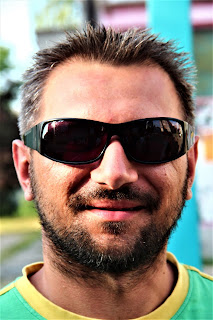
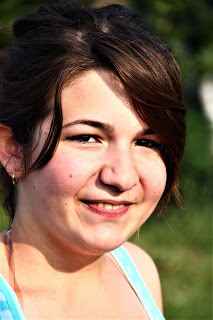








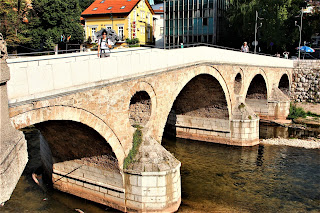











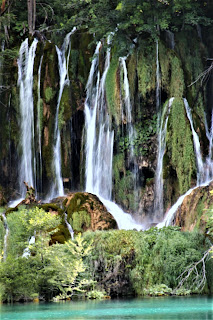









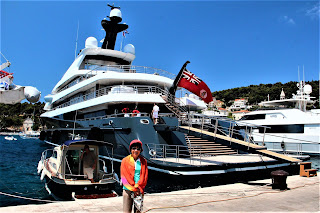











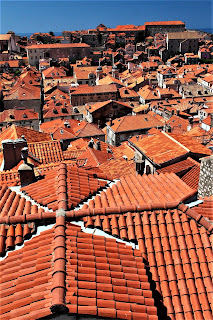






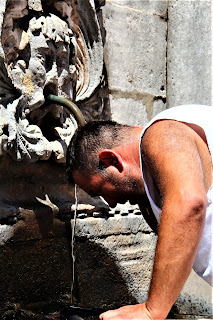

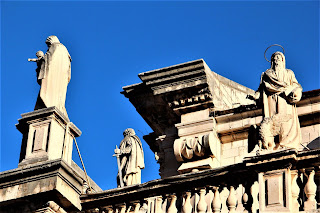

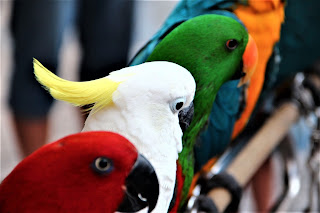
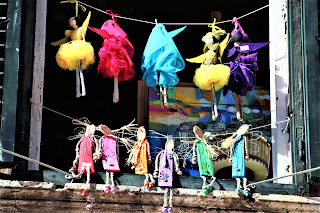
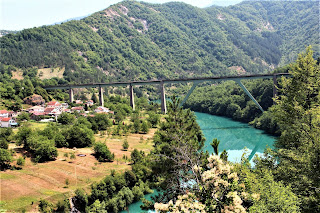



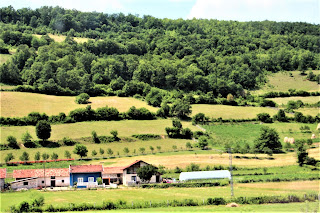
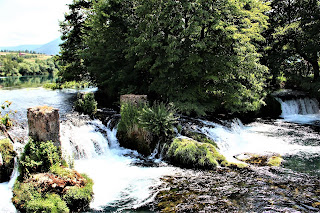





















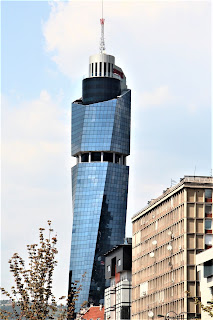










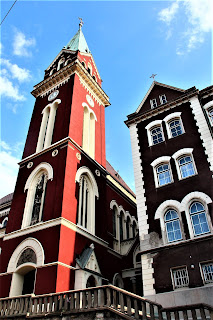


































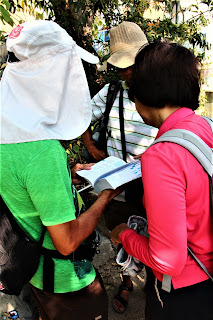





No comments:
Post a Comment